I recently needed to make a short demo lecture, and I thought I’d share it with you. I’m sure I’m not the first one to notice this, but I hadn’t seen it before and I thought it was an interesting way to look at the behavior of polynomials where they cross the x-axis.
The idea is to give a geometrical meaning to an algebraic procedure: factoring polynomials. What is the geometry of the different factors of a polynomial?
Let’s look at an example in some detail: 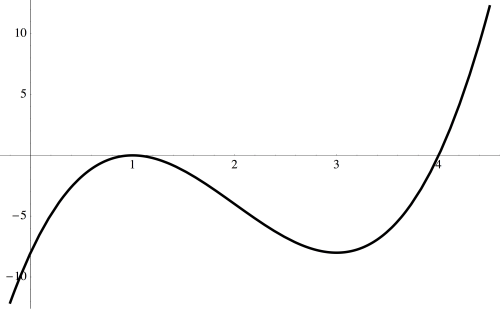
Now let’s start looking at the behavior near the roots of this polynomial.
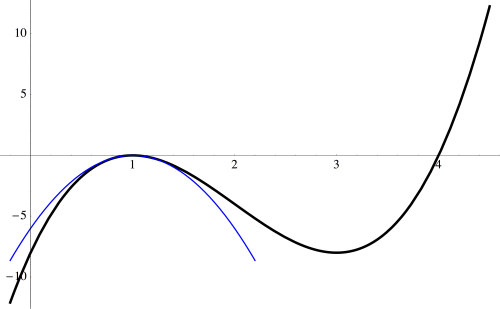
Near the graph of the cubic looks like a parabola — and that may not be so surprising given that the factor
occurs quadratically.
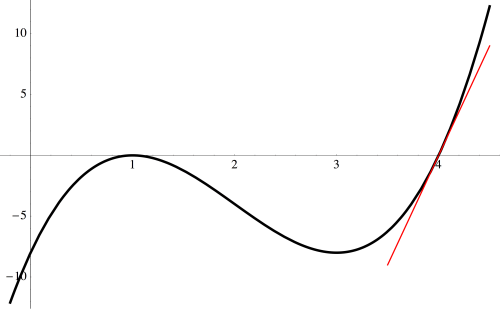
And near the graph passes through the x-axis like a line — and we see a linear factor of
in our polynomial.
But which parabola, and which line? It’s actually pretty easy to figure out. Here is an annotated slide which illustrates the idea.
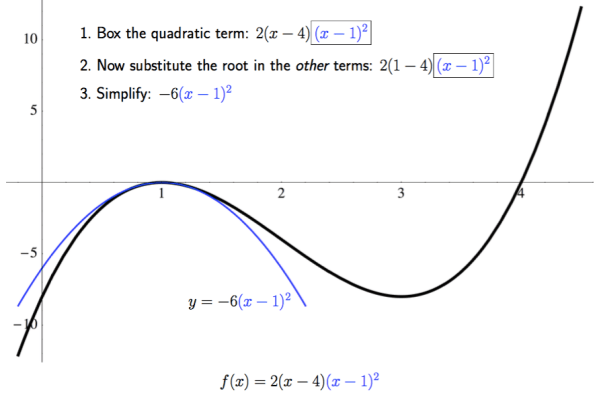
All you need to do is set aside the quadratic factor of and substitute the root,
in the remaining terms of the polynomial, then simplify. In this example, we see that the cubic behaves like the parabola
near the root
Note the scales on the axes; if they were the same, the parabola would have appeared much narrower.
We perform a similar calculation at the root

Just isolate the linear factor substitute
in the remaining terms of the polynomial, and then simplify. Thus, the line
best describes the behavior of the graph of the polynomial as it passes through the x-axis. Again, note the scale on the axes.
We can actually use this idea to help us sketch graphs of polynomials when they’re in factored form. Consider the polynomial Begin by sketching the three approximations near the roots of the polynomial. This slide also shows the calculation for the cubic approximation.
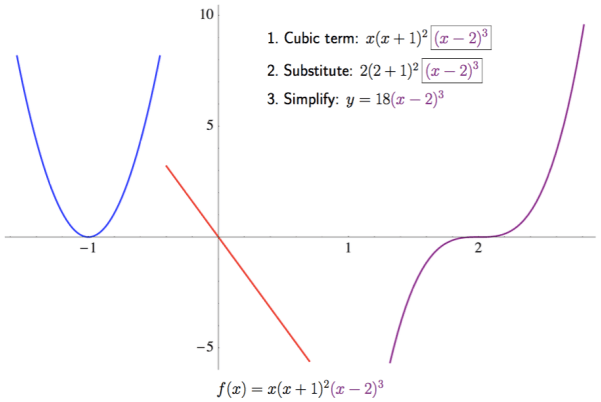
Now you can begin sketching the graph, starting from the left, being careful to closely follow the parabola as you bounce off the x-axis at
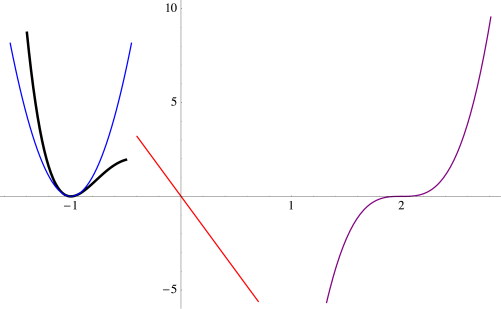
Continue, following the red line as you pass through the origin, and then the cubic as you pass through Of course you’d need to plot a few points to know just where to start and end; this just shows how you would use the approximations near the roots to help you sketch a graph of a polynomial.
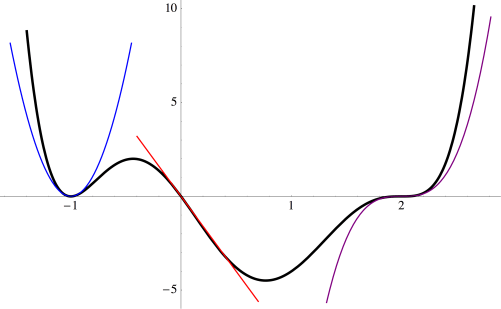
Why does this work? It is not difficult to see, but here we need a little calculus. Let’s look, in general, at the behavior of near the root
Given what we’ve just been observing, we’d guess that the best approximation near
would just be
Just what does “best approximation” mean? One way to think about approximating, calculuswise, is matching derivatives — just think of Maclaurin or Taylor series. My claim is that the first derivatives of
and
match at
First, observe that the first derivatives of both of these functions at
must be 0. This is because
will always be a factor — since at most
derivatives are taken, there is no way for the
term to completely “disappear.”
But what happens when the th derivative is taken? Clearly, the
th derivative of
at
is just
What about the
th derivative of
?
Thinking about the product rule in general, we see that the form of the th derivative must be
When a derivative of
is taken, that means one factor of
survives.
So when we take we also get
This makes the
th derivatives match as well. And since the first
derivatives of
and
match, we see that
is the best
th degree approximation near the root
I might call this observation the geometry of polynomials. Well, perhaps not the entire geometry of polynomials…. But I find that any time algebra can be illustrated graphically, students’ understanding gets just a little deeper.
Those who have been reading my blog for a while will be unsurprised at my geometrical approach to algebra (or my geometrical approach to anything, for that matter). Of course a lot of algebra was invented just to describe geometry — take the Cartesian coordinate plane, for instance. So it’s time for algebra to reclaim its geometrical heritage. I shall continue to be part of this important endeavor, for however long it takes….
Vince – this is really interesting and I am surprised that I have never come across it anywhere before.
Does a similar thing work for functions of two variables? I’m thinking of things that are particularly tough to sketch by hand, like Descarte’s Folium (x^3 + y^3 = 3xy). I have read articles that suggest using something called Newton’s Polygon to sketch these, but I will admit I have not been able to follow the steps that clearly. (My intuition is that this method will not generalize to higher dimensions, because I guess you would have to use partial derivatives, but I am often wrong.)
LikeLike
William – yes, I got it to work with the Folium of Descartes! And in several other cases that I tried as well. Too much to go into here, but I plan to write a more detailed blog post on what I found out in a few weeks (this weekend I’ll be writing about the Bay Area Mathematical Artists). Sorry to keep you in suspense….but thanks for the inspiration!
LikeLiked by 1 person
Well written post.
LikeLike